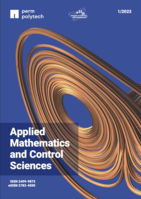Applied Mathematics and Control Sciences
Applied Mathematics and Control Sciences is an open-access periodical scientific peer-reviewed journal.
Full Journal Title: Applied Mathematics and Control Sciences
Abbreviation: Appl. Math. Control Sci.
Publisher: Perm National Research Polytechnic University, Perm, Russian Federation
DOI: 10.15593/2499-9873
Languages: Russian, English
Editor-in-Chief: Professor, Dr. Sci. Valerii Yu. Stolbov
Executive Editor: C.Sci. Aleksandr O. Alekseev
Editorial Contact:
Address: Editorial Board "Applied Mathematics and Control Sciences", Russian Federation, Perm, 614990, Komsomolsky ave., 29
Phone: +7 (342) 219-85-87; + 7 (909) 1000-150
E-mail: aoalekseev@pstu.ru
Frequency: Quarterly
Applied Mathematics and Control Sciences has no article processing and/or article submission charges.
All Journal's Content, including articles, is licensed under a Creative Commons Attribution-NonCommercial 4.0 International License (CC BY-NC 4.0). Editorial of the Journal allows readers to read, download, copy, distribute, print, search, or link to the full texts of its articles and allows readers to use them for any other lawful purpose in accordance with Budapest Open Access Initiative's definition of Open Access.
Journal intended for researchers specializing in the field of applied mathematics, mathematical modeling, differential equations, dynamical systems, optimal control, organizational behavior control, automation, senior students of natural areas.
Since 2019 the journal included in the List of peer-reviewed scientific journals, formed by the Higher Attestation Commission under the Ministry of Science and Higher Education of the Russian Federation.
In 2022 the journal is categorized as category K1 (included in 25% leading Russian peer-reviewed scientific journals).
The years 2022-2031 have been declared the Decade of Science and Technology by decree of the president of the Russian Federation

Current Issue
No 2 (2025)
- Year: 2025
- Articles: 9
- URL: https://ered.pstu.ru/index.php/amcs/issue/view/463
- DOI: https://doi.org/10.15593/2499-9873/2025.2
Abstract
 |  |
Abstract
 |  |
Abstract
 |  |
Abstract
 |  |
Abstract
 |  |
Abstract
 |  |
Abstract
 |  |
Abstract
 |  |
Abstract
 |  |

